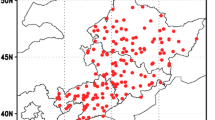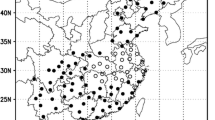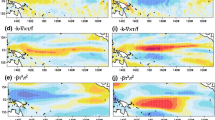Abstract
A method for studying patterns of interannual variability arising from intraseasonal variability has been applied to the extratropical Northern Hemisphere wintertime 500 hPa geopotential height, using data from the NCEP-NCAR. These patterns describe the effects predominantly of intraseasonal variability and blocking. Removing this component from the sample interannual covariance matrix, one can define a “residual”, or “slow”, component of interannual variability that is more closely related to external forcings and very slowly varying (interannual/supra-annual) internal dynamics. For the Northern Hemisphere NCEP-NCAR reanalysis data, there are considerable differences between the intraseasonal patterns and the total patterns. The intraseasonal patterns are more spatially localized and more closely related to known intraseasonal variability, especially blocking events and the Madden-Julian Oscillation. Although the slow patterns and the total patterns look similar, they have some important differences. The slow patterns are more closely related to the slowly varying external forcing and very low-frequency internal dynamics than those derived by the sample covariance matrix. This is evidenced by the fact that the principal component time series of the slow patterns have a larger proportion of variability related to these factors. Where tropical SST forcing is important, the slow patterns tended to be more highly correlated with the interannual variations in the forcing. Three slow modes, related to the Tropical Northern Hemisphere, East Atlantic and Western Pacific teleconnections, are all significantly related to tropical SST variability associated predominantly with the El Nino-Southern Oscillation, in the case of the first two, and Indian Ocean variability, in the third case. The derived slow patterns and intraseasonal patterns may help to better understand the long-range predictability, uncertainty, and forcing of climate variables, for the wintertime circulation.




Similar content being viewed by others
References
Barnett TP (1985) Variations in near-global sea level pressure. J Atmos Sci 42: 478–501
Barnston AG, Livezey RE (1987) Classification, seasonality and persistence of low- frequency atmospheric circulation patterns. Mon Weather Rev 115: 1083–1126
Defant A (1924) Die Schwankungen der atmospherischen Zirkulation ηber dem Nordatlantischen Ozean im 25-jahrigen Zeitraum 1881–1905. Geogr Ann 6: 13–41
Dole RM (1986) Persistent anomalies of the extratropical Northern Hemisphere wintertime circulation structure. Mon Weather Rev 114: 178–207
Frederiksen JS (1982) A unified three-dimensional instability theory of the onset of blocking and cyclogenesis. J Atmos Sci 39: 969–987
Frederiksen JS (1983) A unified three-dimensional instability theory of the onset of blocking and cyclogenesis. II: teleconnection patterns. J Atmos Sci 40: 2593–2609
Frederiksen JS, Bell RC (1987) Teleconnection patterns and the roles of baroclinic and topographic instability. J Atmos Sci 44: 2200–2218
Frederiksen JS, Bell RC (1990) North Atlantic blocking during January 1979: linear theory. Q J R Meteorol Soc 116: 1289–1313
Frederiksen CS, Frederiksen JS (1992) Northern Hemisphere storm tracks and teleconnection patterns in primitive equation and quasigeostrophic models. J Atmos Sci 49: 1443–1458
Frederiksen JS, Frederiksen CS (1993) Monsoon disturbances, intraseasonal oscillations, teleconnection patterns, blocking and storm tracks of the global atmosphere during January 1979 : linear theory. J Atmos Sci 50: 1349–1372
Frederiksen JS, Frederiksen CS (1997) Mechanisms of the formation of intraseasonal oscillations and Australian monsoon disturbances : the roles of latent heat, barotropic and baroclinic Instability. Contrib Atmos Phy 70: 39–56
Frederiksen JS, Puri K (1985) Nonlinear instability and error growth in northern hemisphere three-dimensional flows: cyclogenesis, onset-of-blocking and mature anomalies. J Atmos Sci 42: 1374–1397
Frederiksen JS, Webster PJ (1988) Alternative theories of atmospheric teleconnections and low-frequency fluctuations. Rev Geophys 26: 459–494
Frederiksen CS, Zheng X (2000) Chaos, potential predictability and model validation of climate variations. ANZIAM J 42(E): c608–c626
Gambo K, Weijing L (1987) Numerical simulation of eurasian teleconnection pattern in atmospheric circulation during the northern hemisphere winter.Adv Atmos Sci 4: 385–394
Hendon HH, Liebmann B (1990) A composite study of onset of the Australian summer monsoon. J Atmos Sci 47: 2227–2240
Huang J, Higuchi K, Shabbar A (1998): The relationship between North Atlantic Oscillation and with El Nino-Southern Oscillation. Geophys Res Letts 25: 2707–2710
Kalnay EM et al. (1996) The NCEP/NCAR 40-year reanalysis project. Bull Am Meteorol Soc 77: 437–471
Karoly DJ, Plumb RA, Ting M (1989) Examples of the horizontal propagation of quasi-stationary waves. J Atmos Sci 46: 2802–2811
Kodera K (1998) Consideration of the origin of the different midlatitude atmospheric responses among el nino events. J Meterol Soc Jap 76: 347–361
Knutson TR, Weickmann KM (1987) 30–60 day atmospheric oscillations: composite life cycles of convection and circulation anomalies. Mon Weather Rev 115: 1407–1436
Kutzbach JE (1970) Large-scale features of monthly mean Northern Hemisphere anomaly maps of sea-level pressure. Mon Weather Rev 98: 708–716
Lau N-C, Lau K-M (1986) The structure and propagation of intraseasonal oscillations appearing in a GFDL GCM. J Atmos Sci 43: 2023–2047
Lau N-C, Nath MJ (1994) A modeling study of the relative roles of tropical and extropical SST anomalies in the variability of the global atmosphere-ocean system. J Clim 7: 1184–1207
Lau N-C, Nath MJ (1996) The role of the “atmospheric fridge” in linking tropical Pacific ENSO events to extratropical SST anomalies. J Clim 9: 2036–2057
Lejenäs H, Økland H (1983) Characteristics of Northern Hemisphere blocking as determined from a long time series of observational data. Tellus 35A: 350–362
Livezey RE, Mo KC (1987) Tropical extratropical teleconnections during the Northern Hemisphere winter, Part II: relationships between monthly mean Northern Hemisphere circulation patterns and proxies for tropical convection. Mon Weather Rev 115: 3115–3132
Madden RA (1976) Estimates of the natural variability of time averaged sea level pressure. Mon Weather Rev 104: 942–952
Madden RA, Julian PR (1971) Detection of a 40-50 day oscillation in zonal wind in the tropical Pacific. J Atmos Sci 28: 702–708
Madden RA, Julian PR (1972) Description of global scale circulation cells in the tropics with a 40–50 day period. J Atmos Sci 29: 1109–1123
Mo R, Fyfe J, Derome J (1998) Phase-locked and asymmetric correlations of the Wintertime atmospheric patterns with ENSO. Atmos Ocean 36: 213–239
Rayner NA, Parker DE, Folland CK, Alexander LV, Horton EB, Rowell DP (2003) Globally complete analyses of sea-surface temperature, sea-ice and marine air temperature, 1871–2000. J Geophys Res 180: 4407
Rodwell MJ, Folland CK (2002) Atlantic air-sea interaction and seasonal predictability. Q J R Meteorol Soc 128: 1413–1443
Rodwell MJ, Folland CK (2003) Atlantic air-sea interaction and model validation. Ann Geophys 46: 47–56
Schubert SD, Parl C-K (1991) Low-frequency intraseasonal tropical-extratropical interactions. J Atmos Sci 47: 357–379
Simmons AJ, Wallace JM, Branstator GW (1983) Barotropic wave propagations and instability, and atmospheric teleconnection patterns. J Atmos Sci 40: 1363–1392
Thompson DWJ, Wallace JM (1998) The Arctic Oscillation signature in the wintertime geopotential height and temperature fields. Geophys Res Lett 25: 1297–1300
van Loon H, Rogers JC (1978) The seesaw in winter temperatures between Greenland and Northern Europe. Part 1: general description. Mon Weather Rev 106: 296–310
Walker GT, Bliss EW (1932) World Intraseasonal V. Mem. Roy Meteor Soc 4: 53–84
Wallace JM, Gutzler DS (1981) Teleconnections in the geopotential height field during the Northern Hemisphere winter. Mon Weather Rev 109: 784–812
Wilks DS (1995) Statistical methods in the atmospheric sciences. Academic Press pp 467
Zheng X, Frederiksen CS (1999) Validating interannual variability in an ensemble of AGCM simulations. J Clim 12: 2386–2396
Zheng X, Frederiksen CS (2004) Variability of seasonal-mean fields arising from intraseasonal variability: Part 1, methodology. Clim Dyn (in press)
Zheng X, Nakamura H, Renwick JA (2000) Potential predictability of seasonal means based on monthly time series of meteorological variables. J Clim 13: 2591–2604
Acknowledgements
We would like to thank Drs Huqiang Zhang, Mark Harvey, Bryant McAvaney for their valuable comments. One of us, XZ, would like to thank the New Zealand Foundation for Research, Science and Technology for funding his participation in the study under contract CO1X0202. The HADISST1.1 dataset was kindly supplied by Nick Rayner at the Hadley Centre, UK Meteorological Office. The comments and suggestions of two anonymous reviewers are also appreciated.
Author information
Authors and Affiliations
Corresponding author
Rights and permissions
About this article
Cite this article
Frederiksen, C.S., Zheng, X. Variability of seasonal-mean fields arising from intraseasonal variability. part 2, application to nh winter circulations. Climate Dynamics 23, 193–206 (2004). https://doi.org/10.1007/s00382-004-0429-6
Received:
Accepted:
Published:
Issue Date:
DOI: https://doi.org/10.1007/s00382-004-0429-6




